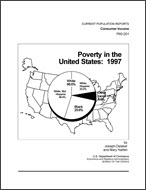Poverty in the United States: 1997
Poverty in the United States: 1997
Introduction
Poor people in the United States are so diverse that they cannot be characterized along any one dimension. Therefore, this report presents poverty data by selected characteristics—age, race and Hispanic origin/1, nativity, family composition, work experience, and geography—to illustrate how poverty rates vary.
Highlights
(Numbers in parentheses denote 90-percent confidence intervals/2.)
- The poverty rate decreased in 1997 to 13.3 (± 0.3) percent, down from 13.7 (± 0.3) percent in 1996. The number of poor people in 1997, 35.6 (± 0.9) million, remained statistically unchanged from 1996.
- The number of poor and the poverty rate decreased for Blacks. In 1997, 9.1 (± 0.4) million or 26.5 (± 1.3) percent of Blacks were poor, down from the 9.7 (± 0.4) million and 28.4 (± 1.3) percent reported for 1996.
- The number of poor and poverty rate decreased for people of Hispanic origin/3: 8.3 (± 0.4) million or 27.1 (± 1.3) percent were poor in 1997, down from the 8.7 (± 0.4) million and 29.4 (± 1.3) percent reported for 1996.
- The declines in the poverty rates of Blacks and people of Hispanic origin accounted for most of the decrease in the overall poverty rate between 1996 and 1997.
- Both the number and percent of families in poverty declined. There were 7.3 (± 0.3) million families in poverty in 1997, down from the 7.7 (± 0.3) million reported for 1996. In 1997, 10.3 (± 0.3) percent of families were in poverty, down from the 11.0 (± 0.3) percent reported for 1996. More than half of the decrease in the number of families in poverty occurred among Black families.
- The poverty rate in central cities declined to 18.8 (± 0.8) percent in 1997, from 19.6 (± 0.8) percent in 1996. This 1997 rate was more than twice that of the suburbs/4—9.0 (± 0.5) percent.
- The 1997 poverty rate was not statistically different from the poverty rate in 1989, when a low point of 13.1/5 percent was achieved during the economic expansion of the 1980s.
- Comparing the two-year moving averages of 1996-1997 with those for 1995-1996, five states had statistically significant changes in their poverty rates. The poverty rate dropped in three states—Alabama, Mississippi, and South Carolina—while two states—Arkansas and New Hampshire—showed an increase.
- If an alternative income definition were used, one which added the value of means-tested noncash transfers (e.g. food stamps, housing subsidies, and medicaid) to post-tax cash income from the private and government sectors, the poverty rate would be 10.0 (± 0.3) percent with 26.9 (± 0.8) million poor people. Neither figure would be significantly changed from 1996.
Following the Office of Management and Budget’s (OMB’s) Directive 14, the Census Bureau uses a set of money income thresholds that vary by family size and composition to detect who is poor (see Table A-2, Appendix A). If a family’s total income is less than that family’s threshold, then that family, and every individual in it, is considered poor. The poverty thresholds do not vary geographically, but they are updated annually for inflation with the Consumer Price Index (CPI-U). The official poverty definition counts money income before taxes and excludes capital gains and noncash benefits (such as public housing, medicaid, and food stamps).
This report also presents data by two other measures: the ratio of income to poverty level and the income deficit. The ratio of income to poverty level shows the number and percent of people with incomes below multiples of their poverty thresholds; the income deficit shows the amount of cash needed to bring all poor families up to their poverty thresholds.
In the early 1980s, the Census Bureau began examining how government noncash benefits affect poverty and how taxes affect measurement of the income distribution. The section entitled ‘‘Alternative Definitions of Poverty’’ presents updated estimates of the incremental effects of benefits and taxes on poverty for 1997.
The numbers in this report are estimates for calendar year 1997, and are based on the March 1998 Current Population Survey (CPS), conducted by the Census Bureau. For more details about how these data were collected, please see the section entitled ‘‘Notes and Users’ Comments.’’
__________
1 People of Hispanic origin may be of any race.
2 For a definition of ‘‘confidence interval,’’ see the section entitled ‘‘Standard Errors and Their Use’’ in Appendix D.
3 See footnote 1.
4 In this report, ‘‘suburbs’’ refers to metropolitan areas outside central cities.
5 The 1989 figures listed in the text and Table A have been adjusted to 1990 census population controls for more meaningful comparisons with figures from the 1990s. As a result, these figures may not match the 1989 figures listed in the time-series tables in Appendix C. The reader is also cautioned that these comparisons are between 1989 and 1997 only and should not be interpreted as a trend.
Charts
Press Briefing
Historical Tables
-
TableHistorical Poverty Tables: People and Families - 1959 to 2022
-
TablePoverty Thresholds
-
TableHistorical Poverty Tables: Poverty by Definition of Income (R&D)
Others in Series
Publication
Publication
Publication








